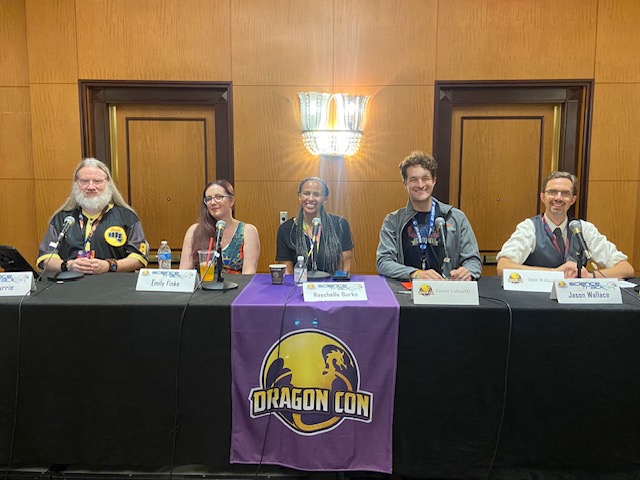Most plants are toxic for mammals. They are the masters of chemical warfare because they can’t run away. The many dangers of plants was the theme of the night in the “Plants that Want to Kill You” panel at 5:30PM on Sunday in the Hilton Crystal Ballroom. Biologist and Science Communicator Forrest Valkai moderated the panel, with panelists Dr. Paul Currie, Emily A. Finke, Raychelle Burks, and Jason Wallace.

The panel started off dark with Valkai asking the panelists their favorite plant families and why is it nightshades? Dr. Currie referenced the manchineel, known in Spanish as manzanilla de la muerte, or “little apple of death.” One of the most dangerous trees in the world, the leaves and stems from the manchineel are so poisonous that if someone stands under the tree while it’s raining the toxin can drip onto their skin and burn them. Also, smoke from a fire made with the wood of the manchineel will temporarily blind you.
Emily Finke discussed the cassava plant, a starchy plant eaten in many areas. However, if you eat it raw you will get cyanide poisoning. To be edible, cassava must be soaked, fermented, and boiled. And Finke noted the crazy thing is cultures learned things like this very fast in the past.
To perhaps the dismay of many coffee drinkers, caffeine is a pesticide, as are most herbs. They developed to kill insects. Fun fact, the English first introduced teatime routines into the work day in order to get their workers to consume caffeine because the workers would work harder and could work longer.
Raychelle Burks asked the audience who loved mangoes. She then noted that unripe mangoes contain the same compounds as poison ivy that causes rashes. People who have allergy problems with that compound who eat mangoes end up with the same rash, but in their throats.
The panel then turned from culinary discussions to medical. Curare, a strong paralytic, relaxes muscles. In a strong enough dose, it relaxes even the muscles required to breathe. From a medical standpoint it’s used in eye surgery to relax the eye because they have to keep patients awake to minimize eye movement during the procedure.
Burks consults for TV and has been asked by writers for ways to kill people. She noted it depends on how bad you want people to suffer. How long does it need to take for the people to die? The writers replied the people are bad, so they need to suffer. Her answer: Strychnine. It causes muscles to convulse and contract to the point the muscles separate from the bone. In some people it can cause the bones to break. Eventually, it leads to death. Worse, it looks like tetanus, so a death would appear accidental.
Dr. Currie noted if white snake root grows around cows, they can eat it. The white snake root gets into the cow’s milk. If people then drink the milk, the toxin first creates stomach cramps, then turns their blood to acid.
Finke added that for multiple years she’s been trying to eradicate lily of the valley from her yard. If a child eats lily of the valley they will die.
Jason Wallace finally raised the question: why are plants trying to kill us? The answer is that it cannot run away like animals. It has to convince you not to eat it, by making eating them incredibly unpleasant. Plants and fungi have become masters of chemical warfare, because it’s their only defense mechanism.
When Valkai asked the other panelists what plants keep them up at night, Finke mentioned poison hemlock or water hemlock. Climate change has allowed water hemlock to spread considerably in the wild. The water hemlock resembles carrots, but will give you nasty burns if handled.
Burks brought up peppermint. She loves peppermint, the smell and flavor. However, peppermint can be suffocating. She mentioned a story where a worker at a peppermint distillery had gone into a tank to clean it and fell unconscious. Four other workers entered the tank and they all fell unconscious. The first died from the suffocation, while the others ended up in ICU.
Finke added to that by noting she used to love peppermint tea and would drink five cups per day until it made her heart race to the point where she thought she was suffering from a panic attack. She had to cut way down on the peppermint consumption.
Wallace noted there are also many foods that are normally safe to eat, but can be infected. In the U.S., our foods are tested to ensure safety. In third world countries, that testing doesn’t exist. Poor, subsistence farmers in some parts of the world grow food to eat, and end up with throat cancers from issues in their crops that they can’t afford to test. Even animal products in the U.S. are carefully tested to ensure nothing animals eat has been contaminated. That’s not the case everywhere.
Finke and Burks also warned audiences to take care with specialty teas and natural foods stores, because things that people believe have medicinal qualities when used the wrong ways can cause tremendous harm. Finke is particularly concerned about the rise of the raw food diet because so many foods have toxins that need to be cooked to eliminate.
On top of that, they discouraged amateur foraging because so many poisonous plants look very similar to harmless versions, the mushroom family being a prime example. Foraging can be great but requires a lot of training to avoid the dangers.
The panel eventually ran out of time before the panelists could answer all the questions from the enthusiastic audience, leaving them hungry for more.
